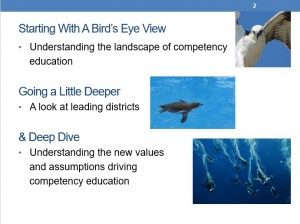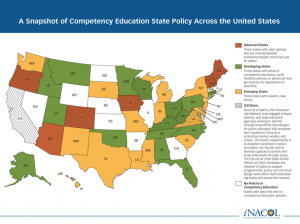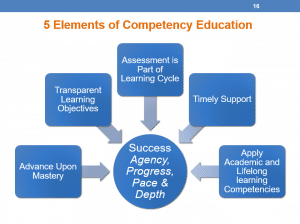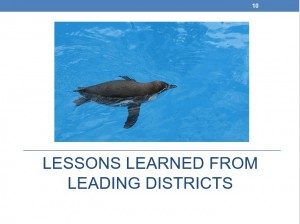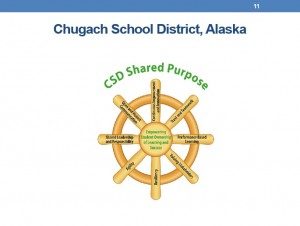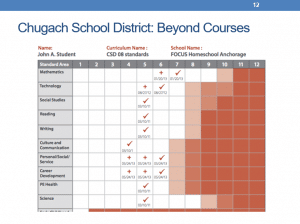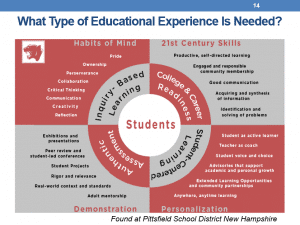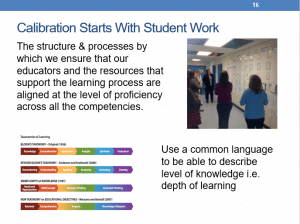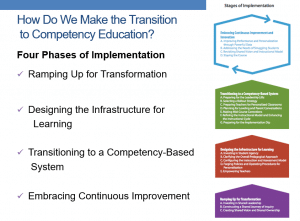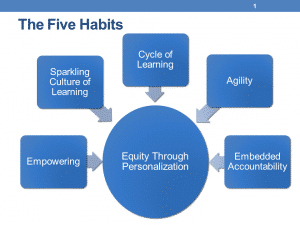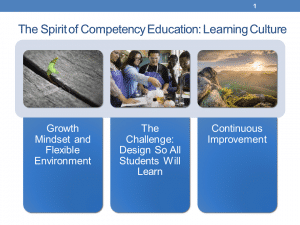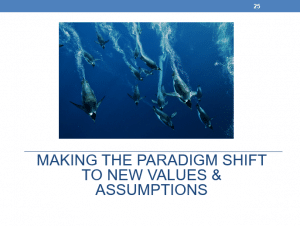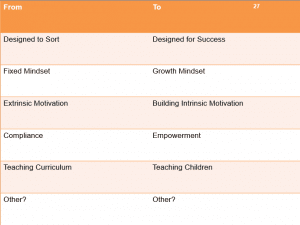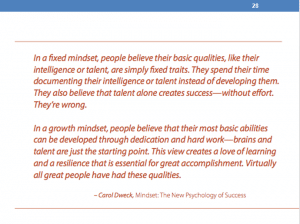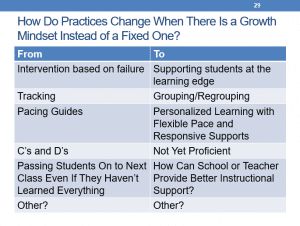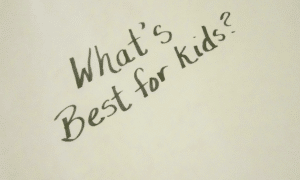Developing a Growth Mindset at Fraser Public Schools
CompetencyWorks Blog
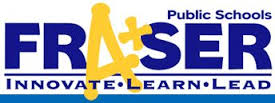 The following is a presentation made at Fraser Public Schools on September 2. Fraser has already invested in integrating technology into their classrooms and developing blended approaches to learning. They are now seeking to develop a competency-based infrastructure that will ensure students get the support they need.
The following is a presentation made at Fraser Public Schools on September 2. Fraser has already invested in integrating technology into their classrooms and developing blended approaches to learning. They are now seeking to develop a competency-based infrastructure that will ensure students get the support they need.
This presentation explores what competency education is, examines how districts are developing their models, and takes a deeper dive into the new values and assumptions underlying personalized, competency-based systems and how they shape new practices. For those of you wanting to skip ahead of the definition, the section on districts starts at slide 10 and the section on the new values starts on slide 25.
There are many ways to open the door to discussion of competency education. We could talk about why the traditional system doesn’t work or we could start with the classroom and expand into policy. Today, we’ll start with a bird’s-eye view of competency education and then go a bit deeper to visit some of the leading districts to find out what they are learning. We’ll wrap up with a look at the new set of values and assumptions that drive competency education.
Competency education is called different things in different states – ME and OR call it proficiency-based; CT calls it mastery-based; IA and NH call it competency-based. As soon as we update this map, we hear of another state taking a step forward. In June, it was Idaho and Ohio. I just heard that Nevada is starting a study group to learn more about it. It is spreading across the country because educators believe it is the best thing for kids.
I am confident that we are going in the right direction because many districts, without enabling state policy, are converting their schools to competency education. Examples include Lindsay in California, Warren and Springdale in Arkansas, Charleston in South Carolina, Henry and Fulton in Georgia, Freeport in Illinois, and Lake County in Florida.
Competency education has started in smaller districts in rural areas and inner ring suburbs. We think smaller districts are better positioned to make the change because it’s easier to engage community and easier to have more dialogue rather than resorting to memo/email for communication.
When districts convert, they keep many pieces of the traditional system in place – often for good reason. However, new schools and charter schools offer us insights into other ways that we can begin to organize educational experiences. I’ll highlight just a few of the interesting practices that have been developed in different schools.
- Schools will vary in how individualized or organized around a cohort. BDAE is highly individualized model designed for students with gaps in skills and credits. Casco Bay, on the other hand, deeply values creating a community of learning so students are expected to work together through four years of high school.
- Schools are also creating different ways to think about how students advance. Some, such as Lindsay Unified School District, continue to use grade levels, but students may operate at different academic levels. Schools for the Future has developed four performance levels in which students progress based on a number of important benchmarks, including academic skills.
- Schools are also expanding how we think about sequencing. Making Community Connections invests heavily in helping students develop habits of learning and expects the academic achievement to develop naturally as students feel confident in themselves as learners. EPIC invests heavily in leadership before the school year to help students reflect on their educational experiences and build a strong community of students dedicated to supporting each other.
- Schools are also integrating project-based learning in different ways. Chugach School District has Independent Learning Plans for students to co-design projects that are of interest to them with their teachers. Highland Tech courses are organized around project-based learning with most classes having several opportunities for projects to develop and apply learning. Boston Day and Evening Academy organizes project-based learning once a year in December to ensure that students have the opportunity to apply their learning.
- Schools also design around the needs of historically underserved students in different ways. Carroll Gardens designed with needs of students with disabilities in the center, recognizing that we can all learn better when we think about how we can set the conditions, accommodations, and extra support we need to be successful.
The thing these schools have in common is that they all designed by putting the needs of their most struggling students in the center of their design. EPIC, designed around the needs of young men of color, starts with an emphasis on student voice and cultural relevance to help students develop an analysis that empowers them as learners and leaders.
It’s important to understand competency education within the context of the huge transformation taking place. The traditional system is based on time-based credits and age-based cohorts, and relies on the extrinsic motivation of competition, points, and A-F grading to motivate students. Efficiency is the value that drives it – thus we refer to it as a factory model.
What are we going to call the new system? I think it is best to describe it as a personalized system in contrast to describing the traditional system as a factory model. Right now, our best thinking to date is that to create a personalized system, we need to have a competency-based structure, a student-centered approach (sometimes referred as personalized learning) that engages and motivates students to have greater ownership over their education, and then the technology to offer more flexibility in pace, place, and path.
The traditional, time-based system was never designed to ensure equity. In fact, it depended on similar curriculum and amounts of instruction to be able to sort students. In comparison, we are re-engineering to create a personalized, competency-based system to make sure every student is learning every step of the way so they are prepared for the next level of study and the next stage of their life.
Here is one of the better definitions of personalized learning with what I see as three elements – understanding needs and interests, emphasizing voice, and creating more flexibility.
We still have a ways to go to really understand the implications of student agency, voice, and choice. Student agency is based on students having the skills or the habits of learning to manage their learning. Voice is expression, contributing, and leadership. Choice is probably the easiest – how am I learning something and how am I demonstrating that I know it.
We want to design a system that is personalized enough to ensure all students are successful, especially those who have been historically underserved: low income, Native American, African American, Latinos, English language learners, and our students with disabilities. Even if you have a highly personalized approach, how do we ensure students are going to be successful? We are designing a system in which failure is not an option.
The discussion these days is very confusing about personalization because two different camps use the same terms – those that emphasize relationship and student voice and those that emphasize technology. And you will notice that I called the system we are building a personalized system, but make a distinction with a personalized approach to learning.
In 2011, 100 innovators in competency education gathered together to create a working definition of competency education. It has five components and ALL FIVE ELEMENTS are NECESSARY.
- Students advance upon demonstrated mastery. This means we need to create the capacity to support students who need more help as well as the ability to let students fly beyond their grade level.
- Explicit, measurable, transferable learning objectives that empower students require intentionality and transparency. The issue of empowerment (what we often call student agency, voice, and choice) is an enormous change. Personalized learning and student agency are two sides of the same coin. In order to run personalized classrooms, students need to take a much higher degree of ownership of their education so teachers are not needed to answer every questions. I have been in classrooms where students are all working on different units. They know exactly what they are working on, how to get help if they get stuck, and what they need to do to demonstrate mastery. It’s all because of transparency, establishing a strong culture of learning with tools and protocols to support student agency, and coaching as students build the habits of learning.
- Assessment is meaningful and a positive learning experience for students. We want students to be able to fully participate in the cycle of learning by receiving timely feedback. If the feedback comes too late or without enough information for a student to address their misconceptions, it is not a positive learning experience. In addition, we challenge the notion that students should take summative exams before they have demonstrated proficiency.
- Students receive timely, differentiated support based on their individual learning needs. Competency-based education is built firmly upon a growth mindset in which we believe with the right conditions and supportive environment, students can learn. This means that students are working in their zone of proximal development and receiving more instructional support when they need it. I think of it as just-in-time support. One of the most basic practices we see is Flex Hour so students can get help every day. However, I will raise the question still to be answered – what exactly will it take in terms of environment and supports to help low-income students learn? My guess is that it isn’t more recall and comprehension. We will need much more high engagement strategies that expose them to the marvelous world around them to ignite wonder, awe, and curiosity.
- Learning outcomes emphasize application and creation of knowledge, along with the development of important skills and dispositions. This requires us to think broadly about all the skills students need, including habits of learning, as well as to ensure we are creating opportunities for students to apply their skills in new contexts. In other words, we need to have the capacity for project-based or real-world learning and performance-based assessments.
Competency education starts with the assumption that students are going to be at different points along the learning continuum. In the sixth grade you have students with a variety of skills and maturity. One may read at eighth grade but do sixth grade math. Another might have sixth grade math skills but huge gaps and essentially be reading at fourth grade and writing at third grade level. Some may have more ownership over their education and well-developed habits of learning while others need much more guidance and structure. Some may have already disengaged from years and years of experiencing failure.
I’d like to address the misconception that competency education is only about pace. The phrase “learning is a constant and time is a variable” has led many to believe that competency-based education is synonymous with online learning. That is wrong. Competency-based education is much more than pace and time – it a structure to ensure students succeed. Online learning can be incredibly helpful in a competency-based school, but progressing through software or an online curriculum does not necessarily provide transparency, extra support, and opportunities for deeper learning.
In a competency-based district, educators are keeping their eye on depth of learning and pace to make sure students are making progress.
When I’ve visited schools where all five of these elements are in place, I have found motivated students, incredibly engaged educators collaborating on how to improve instruction and their skills, and this phenomenal culture of innovation. Ty Cesene of Bronx Arena said it best: We aren’t going to stop innovating until 100% of our students are graduating.
Now we are going to visit a number of the leading districts that have converted to competency education to find out what their systems look like and highlight a few of the lessons learned.
Chugach School District is based in Anchorage and serves three remote (really remote) school districts. Communities there challenged the school district, saying that their children were not learning to read. The superintendent had the courage to own up to this. They implemented a reading program which improved reading but nothing else. And they realized there was a bigger problem in the system itself.
They began to re-design the system starting with engaging the community to define what they wanted for their children. Over the next twenty years they developed a highly personalized, performance-based system.
They developed a district-wide shared purpose that drives everything. Each school developed a similar shared purpose but written in a way that relates to their particular community. The elements of the shared purpose of the district are:
- Continuous Improvement and Innovation
- Trust and Teamwork
- Performance-Based Learning
- Valuing Stakeholders
- Resiliency
- Agility
- Shared Leadership and Responsibility
- Open and Honest Communication
- Empowering Student Ownership of Learning and Success
One of the strongest themes that came through in my visit was the unflinching focus on student empowerment rooted in the district culture, relationships, and structure.
Chugach has developed ten domains that go far beyond academic disciplines, responding to the desire of the community for their children to be well-rounded and recognizing that motivation and engagement are based on students having an opportunity to develop interests. In addition to academics, there is culture & communication (student will understand and appreciate the unique aspects of their own culture, as well as Alaska Native or world cultures), personal/social/service (the values and skills necessary to reach one’s full potential and foster the development of those around them), career development and physical education/health (healthy interpersonal strategies that apply in both rural and urban environments), and science. The graduation requirements are based on reaching specific levels for each content area. Of course, students progress through the levels at their own pace.
The levels do not necessarily correspond with age-based grades. Within those levels are learning goals or standards.
Teachers are responsible for credentialing the learning within the levels, but when a student moves from one level to the next, the district has a set of cumulative assessments to ensure students are ready.

Lindsay School District started over six years ago with a robust community engagement strategy. They developed a set of lifelong learning standards that drive how the school is organized and how they are supporting their students. They started with high school and are rolling back to earlier grades.
They worked with Reinventing Schools Coalition to develop a performance-based infrastructure in which students know exactly what they are supposed to know, what proficiency looks like, and how they are going to be assessed. They also worked with Bea McGarvey on creating a highly personalized or customized approach to learning, which creates much more flexiblity in the school to be responsive to student needs.
They have developed a state-of-the-art information system called Empower to support them so they can track student progress – it also allows school leadership and departments to see how students are progressing and where there might be issues in terms of teaching capacity. Students and parents can also look to see how students are progressing and which courses offer the standards they need to develop.
One of the most interesting things they are doing is identifying the adult competencies needed to be effective in a personalized, performance-based school. They are taking student agency very seriously and rethinking the roles of educators to help students build habits of learning as well as manage learning experiences.
Pittsfield School District in New Hampshire started with a focus on creating a student-centered district as their overarching goal. They too started with high school and are rolling back to earlier grades. They fully engaged their community in setting the direction for what they wanted for their students described here as habits of mind and twenty-first century skills. They realized they needed to create more opportunities for students to be active learners. They invested in building student voice and changing the relationship with educators. Students now are part of governance and committees, and it is having an impact. For example, as they reviewed school disciplinary policies, students raised the concern that it wasn’t consistent with the values of creating a culture of learning, so they have now embraced restorative justice as the primary disciplinary strategy. They have also embraced extended learning opportunities. Students are able to co-design projects in which they are able to learn or develop their competencies – some academic and some twenty-first century skills.
There are two huge changes that happen in every school district that converts to competency based education.
The first is when a district begins to design for a system in which failure is not an option. Once you remove the option to move students on with a C or a D, a district has to rethink what else needs to be in place. Traditional grading based on assignments, assessments, and extra credit is replaced by scoring that focuses on how students are progressing in their learning. This is often called standards-referenced grading.
Districts also develop the capacity for students to keep learning until they reach proficiency. This is called standards-based grading. Creating a flex hour, increased availability of targeted tutoring and access to other teachers to help them, and competency recovery that kicks in the minute a student is struggling are all techniques that are used. Some schools get swept up in re-assessment and re-teaching, but that usually happens when they haven’t had a student demonstrate proficiency before taking a summative exam or are using time-based exams that are organized around the calendar instead of student learning. When the school is more personalized, students just keep working with formative feedback until they demonstrate proficiency. Some schools get into trouble with students, often honor students, not studying before exams because they know they can take a re-assessment. This is an indicator that they don’t have clear habits of learning being assessed. No honor student wants inconsistently demonstrates preparation or needs improvement in professional responsibility anywhere on his school record.
The second capacity we need to build is calibration or tuning. Even if you have well-written competencies and standards, teachers have to look at and talk about student work to really understand what proficiency looks like. This also opens the door to much deeper conversations about where the depth of knowledge instruction and assessment is set at.
Calibration usually happens in professional learning communities or departments. At Memorial Elementary School in Sanborn, New Hampshire, they recognized they had a problem in terms of being able to help their students write. To build a shared understanding of writing at the different academic grade levels, they set up a wall with all the academic levels showcasing samples of student work. They then placed stars to indicate how many students in each grade were writing at each academic level. Teachers, parents, and students can all look at the wall to understand what “good writing” looks like at each level.
Calibration becomes even more important when we are using a lot of blended learning, as the digital content may not be using the same idea of what it means to be proficient. It’s tremendously important that this knowledge be embedded within schools themselves.
I wish I could describe how we make the conversion from a traditional system to personalized one that is able to integrate competency education, personalization, and blended learning. But we haven’t had any examples of districts that did all three simultaneously. We are starting to try to figure that out.
What I can talk about is the process to competency education. CompetencyWorks released a paper this summer called Implementing Competency Education in K-12 Systems: Insights from Local Leaders. Based on discussion with district and school leaders, we identified four phases – ramping up, designing the infrastructure for learning, the actual transition and then entering into continuous improvement.
The first phase, Ramping Up for Transformation, is absolutely the most important stage. It is the stage in which the new values and assumptions are developed and educators have a chance to understand the implications. It is the time that districts and schools shift from compliance-oriented strategies to creating empowering organizations that can produce sparkling cultures of learning. It is through developing shared leadership in a shared journey of inquiry that we develop the spirit of competency education – empowerment and a love of learning.
I’ve come to believe that if a district or school skimps on the ramping up process, they won’t be able to sweep away the underlying values of the traditional system or build the new habits that will drive the competency-based system.
Based on visits to over thirty schools – some more personalized than others, some using technology more than others, some much more innovative in school design than others, and some having real difficulties – I’ve come to think about the five fundamental habits of competency education.
They are:
- Empowerment
- A Sparkling Culture of Learning
- Constant Attention to the Cycle of Learning
- Agility
- Embedded Accountability
These habits are what we must hold dear, constantly nurturing them. They are the values upon which the system rests.
Let’s explore the first two in detail, as they are essential to effective implementation.
What does it mean to have an empowering system? Moving from the traditional compliance-oriented, top-down system to one that is empowering is an enormous change. To make this change, we need:
- Leadership styles to change. The only way to create an empowered organization is to use adaptive or distributive leadership that is constantly developing leadership in others.
- Students to be more empowered or expected to have agency. In some ways, the traditional system assumes huge amounts of student agency but doesn’t provide any supports to students to develop it. This is one of the ways we continue to create inequity. In competency education, we are going to help students develop the skills they need to be successful learners and have more ability to manage their learning.
- Schools and educators require more autonomy to be able to respond to students. Decision-making needs to shift to be much closer to students.
- There is no doubt that transparency in what we expect to students to learn and in decision-making is a required ingredient in creating an empowering organization.
Honestly, I couldn’t figure out the right word to describe the learning culture I see in well-developed competency-based schools. It does sparkle. Students and educators take pride and find joy in learning, including being comfortable talking about mistakes and failures.
One of the hardest things we all have to come to terms with is that the traditional system wasn’t designed around learning – for students or for adults. It assumes a fixed mindset. We think that some kids are just going to do better than others, whether because of aptitude or because of income.
A competency-based system has to first start with the growth mindset and the understanding of how environment shapes our mindset and our learning. We have to allow ourselves to be challenged by the concept that “all kids can learn.” We all encounter situations where it is hard to imagine how the student is going to learn, and those are exactly the times we have to go ask for help ourselves.
Second, a sparkling culture of learning requires designing so students love learning – by being inquiry-based, motivating, engaging, and doing projects. Learning is fun – it may be really challenging – but it is fun.
Third, the adults all have to commit to continuous learning, both as an organization and in their professional development. Systems will need to be designed so that adults feel supported, recognized, and valued for their learning.
The first phase, Ramping up for Transformation, is absolutely critically important. It is the stage in which the new capacities are developed to create empowering organizations that can produce sparkling cultures of learning. It is through developing shared leadership in a shared journey of inquiry that we develop the spirit of competency education – empowerment and a sparkling culture of learning.
I’ve come to believe that if a district or school skimps on the Ramping Up process, they won’t be able to sweep away the underlying values of the traditional system or build the new habits that will drive the competency-based system. Or as Bob Crumley from Chugach School Districts says…it will come back to bite you.
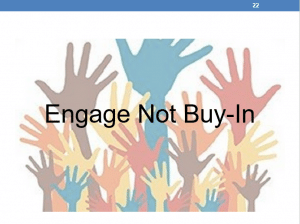
- Picture from the National Federation of Community Broadcasters.
There is a big difference between an engagement strategy and a buy-in. In buy-in, the superintendent or principal develops the strategy and sets up meetings in the community to sell the idea. In engagement, meetings are organized in which there is facilitation in order to be able to listen and learn from the community, parents, and students. Educators have to give up some control…but the trade-off is that you get a shared vision and everyone working in the same direction.
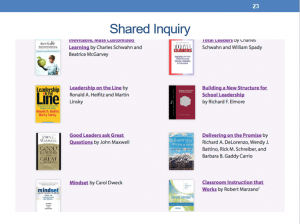
One of the ways that districts begin to develop shared understanding is by studying a book or video together to catalyze discusion. These are some of the books that leading districts have used. Some are about developing new ideas about what schools can look like. Some are about building new leadership strategies that are distributive, in which the job becomes managing inclusive processes and developing leadership in others.
Now we are going to explore the values and assumptions that are driving a personalized, competency-based system.
One of the things that is really important to remember about competency education is that it is based on a different set of values and assumptions than the traditional system. I’m sure you’ve seen this drawing before.
Who sees the young woman?
Who sees the old woman?
The first time I started using this image, I could not see the old woman for the life of me. The more I see it, the easier it is for me to switch back and forth, but I still have to look for her. That is the power of a paradigm shift – with a different perspective one sees new opportunities. But we have to train ourselves in the new perspective.
Increasingly, districts are approaching competency education as a technical reform rather than taking the time to understand the shift in the paradigm. I think this is a problem. The new values and assumptions are absolutely essential, otherwise the new competency-based system doesn’t work smoothly
Here are a few of the new assumptions:
- The traditional system was designed based on efficiency and sorting. A personalized system is designed for success where failure is not an option.
- The traditional system was based on a fixed mindset in which we were comfortable that some kids were going to do better in school because of increased aptitude or income. Competency education starts with a growth mindset.
- In a traditional system, the assumption is that competition and extrinsic motivation of points and GPA will inspire students to work hard. We know that works for some, but probably not more than 10 percent of the population. Instead we are now trying to develop intrinsic motivation through student agency, highly engaging strategies, and helping students find purpose for their learning in the short-run and long-run. This may be exhibitions, addressing issues in their communities, or career development.
- In traditional system, compliance was the primary value of the adults and the students. In competency education, empowerment is a strong value with educators able to respond to children’s needs and students developing ownership over their education.
- The traditional system is based on the delivery of curriculum, again with some students learning and others not so much. In competency education teachers teach children, not a curriculum.
Honestly, I’m still trying to fully understand the differences in values and assumptions. It’s most likely that you will feel a bit disoriented as you begin to embrace a new set of values and assumptions. At many districts, it creates a sense of urgency to change because once teachers come to terms with the problems of the traditional system, they can’t tolerate operating in it any more. After a few years, people fully re-orient to the new values and assumptions, although sometimes it is hard to get rid of some of the traditional practices and rituals. When you talk to people at Lindsay and Chugach – they just live and work in a different paradigm. It’s all crystal clear to them.
Let’s explore one of these new values – the growth mindset. We talk about the growth mindset for students, but I think the big change is that the adults build the growth mindset for themselves. Creating a culture of learning starts with the adults in the schools.
Carol Dweck, professor at Stanford University and the theorist behind the growth and fixed mindset, explains that: “The growth mindset is based on the belief that your basic qualities are things you can cultivate through your efforts. Although people may differ in every which way—in their initial talents and aptitudes, interests, or temperaments—everyone can change and grow through application and experience.”
We have to ask What will it take for adults to learn? Then we can start to think about what it would take to make sure every student is successful.
What are some of the practices we see in competency-based schools based on replacing the fixed mindset with a growth one?
- One of the most clear changes is that in traditional schools, support comes in the form of an intervention that is generally associated with failure or disability. As previously mentioned, learning in a competency-based environment means pushing students and adults to the edge of their comfort zone and competence — the learning edge with support always available.
- Other changes are from tracking to frequent regrouping based on how to best support students and deploy teachers.
- Instead of pacing guides for how the curriculum is delivered, the focus becomes on student pace and what is needed to make sure they are progressing.
- Instead of passing students on with Cs and Ds, the phrase not yet proficient is used.
- Instead of passing students on when they haven’t learned, districts use the data to better understand where they need to build their expertise and capacity. It’s continuous improvement.
This is obviously a big change and may feel like a lot of work. But if you create a shared vision, a new set of shared values, and a clear pedagogical approach based on the whole child…and then let this question, What’s Best for Kids? guide you, I am very confident you will find that the process is really just learning. And in that, you can find shared joy.
People ask me why I focus so much on competency education rather than the broader next generation learning with all the cool technology. There are two reasons. First, without competency education, personalized learning and blended learning are at risk as much as any other reform of not challenging the inequity in our communities and in our system. I think competency education is the best approach for creating an equitable system. Second, the structural changes are hard – they are one half technical and one half values. In my mind, it is the respect, the empowerment, the belief that we can all grow that inspires me.
